I need help understanding the Pan Tompkins algorythm and Id
I need help understanding the Pan Tompkins algorythm, and I\'d also like to know how to detect QRS peaks of the ECG (with circles, for example). I\'m using the script in this website as a guidance, but I have trouble understanding what it\'s doing. Perhaps there\'s a simpler way to do it? http://cnx.org/contents/YR1BUs9_@1/QRS-Detection-Using-Pan-Tompki
Our teacher has otherwise explained to us FIR filters, and wants us to use them instead of the low pass, high pass that are mentioned in the website and though I do understand how they work, I don\'t really know which window is the best, or how many coefficients the filter needs. I\'ve applying the cut-off frequencies 5-15 because I\'ve seen that\'s where the QRS peaks are concentrated. Is there any way to improve this as well?
TB=1;
TBn=TB/Fs;
N2=ceil(3.3/TBn);
Fc1 =5;
Fc2 =15 ;
wc1 = 2*pi*Fc1;
wc2 = 2*pi*Fc2;
wcn1 = 2*pi*Fc1/Fs;
wcn2 = 2*pi*Fc2/Fs;
Bz=fir1(N2,[wcn1 wcn2]);
y3=filter(Bz,1,x1);
figure; plot(x1); figure; plot(y3);
Solution
Save the function and use it as given below ::
pan_tompkin(ECG1,200,1) 1st is ECG raw data , 2nd is sampling frequency, 3rd is for plots -always set it to 1
Matlab Code ------------------------------------ function .
function [qrs_amp_raw,qrs_i_raw,delay]=pan_tompkin(ecg,fs,gr)
%% function [qrs_amp_raw,qrs_i_raw,delay]=pan_tompkin(ecg,fs)
% Complete implementation of Pan-Tompkins algorithm
%% Inputs
% ecg : raw ecg vector signal 1d signal
% fs : sampling frequency e.g. 200Hz, 400Hz and etc
% gr : flag to plot or not plot (set it 1 to have a plot or set it zero not
% to see any plots
%% Outputs
% qrs_amp_raw : amplitude of R waves amplitudes
% qrs_i_raw : index of R waves
% delay : number of samples which the signal is delayed due to the
% filtering
if ~isvector(ecg)
error(\'ecg must be a row or column vector\');
end
if nargin < 3
gr = 1; % on default the function always plots
end
ecg = ecg(:); % vectorize
%% Initialize
qrs_c =[]; %amplitude of R
qrs_i =[]; %index
SIG_LEV = 0;
nois_c =[];
nois_i =[];
delay = 0;
skip = 0; % becomes one when a T wave is detected
not_nois = 0; % it is not noise when not_nois = 1
selected_RR =[]; % Selected RR intervals
m_selected_RR = 0;
mean_RR = 0;
qrs_i_raw =[];
qrs_amp_raw=[];
ser_back = 0;
test_m = 0;
SIGL_buf = [];
NOISL_buf = [];
THRS_buf = [];
SIGL_buf1 = [];
NOISL_buf1 = [];
THRS_buf1 = [];
%% Plot differently based on filtering settings
if gr
if fs == 200
figure, ax(1)=subplot(321);plot(ecg);axis tight;title(\'Raw ECG Signal\');
else
figure, ax(1)=subplot(3,2,[1 2]);plot(ecg);axis tight;title(\'Raw ECG Signal\');
end
end
%% Noise cancelation(Filtering) % Filters (Filter in between 5-15 Hz)
if fs == 200
%% Low Pass Filter H(z) = ((1 - z^(-6))^2)/(1 - z^(-1))^2
b = [1 0 0 0 0 0 -2 0 0 0 0 0 1];
a = [1 -2 1];
h_l = filter(b,a,[1 zeros(1,12)]);
ecg_l = conv (ecg ,h_l);
ecg_l = ecg_l/ max( abs(ecg_l));
delay = 6; %based on the paper
if gr
ax(2)=subplot(322);plot(ecg_l);axis tight;title(\'Low pass filtered\');
end
%% High Pass filter H(z) = (-1+32z^(-16)+z^(-32))/(1+z^(-1))
b = [-1 0 0 0 0 0 0 0 0 0 0 0 0 0 0 0 32 -32 0 0 0 0 0 0 0 0 0 0 0 0 0 0 1];
a = [1 -1];
h_h = filter(b,a,[1 zeros(1,32)]);
ecg_h = conv (ecg_l ,h_h);
ecg_h = ecg_h/ max( abs(ecg_h));
delay = delay + 16; % 16 samples for highpass filtering
if gr
ax(3)=subplot(323);plot(ecg_h);axis tight;title(\'High Pass Filtered\');
end
else
%% bandpass filter for Noise cancelation of other sampling frequencies(Filtering)
f1=5; %cuttoff low frequency to get rid of baseline wander
f2=15; %cuttoff frequency to discard high frequency noise
Wn=[f1 f2]*2/fs; % cutt off based on fs
N = 3; % order of 3 less processing
[a,b] = butter(N,Wn); %bandpass filtering
ecg_h = filtfilt(a,b,ecg);
ecg_h = ecg_h/ max( abs(ecg_h));
if gr
ax(3)=subplot(323);plot(ecg_h);axis tight;title(\'Band Pass Filtered\');
end
end
%% derivative filter H(z) = (1/8T)(-z^(-2) - 2z^(-1) + 2z + z^(2))
h_d = [-1 -2 0 2 1]*(1/8);%1/8*fs
ecg_d = conv (ecg_h ,h_d);
ecg_d = ecg_d/max(ecg_d);
delay = delay + 2; % delay of derivative filter 2 samples
if gr
ax(4)=subplot(324);plot(ecg_d);axis tight;title(\'Filtered with the derivative filter\');
end
%% Squaring nonlinearly enhance the dominant peaks
ecg_s = ecg_d.^2;
if gr
ax(5)=subplot(325);plot(ecg_s);axis tight;title(\'Squared\');
end
%% Moving average Y(nt) = (1/N)[x(nT-(N - 1)T)+ x(nT - (N - 2)T)+...+x(nT)]
ecg_m = conv(ecg_s ,ones(1 ,round(0.150*fs))/round(0.150*fs));
delay = delay + 15;
if gr
ax(6)=subplot(326);plot(ecg_m);axis tight;title(\'Averaged with 30 samples length,Black noise,Green Adaptive Threshold,RED Sig Level,Red circles QRS adaptive threshold\');
axis tight;
end
%% Fiducial Mark
% Note : a minimum distance of 40 samples is considered between each R wave
% since in physiological point of view no RR wave can occur in less than
% 200 msec distance
[pks,locs] = findpeaks(ecg_m,\'MINPEAKDISTANCE\',round(0.2*fs));
%% initialize the training phase (2 seconds of the signal) to determine the THR_SIG and THR_NOISE
THR_SIG = max(ecg_m(1:2*fs))*1/3; % 0.25 of the max amplitude
THR_NOISE = mean(ecg_m(1:2*fs))*1/2; % 0.5 of the mean signal is considered to be noise
SIG_LEV= THR_SIG;
NOISE_LEV = THR_NOISE;
%% Initialize bandpath filter threshold(2 seconds of the bandpass signal)
THR_SIG1 = max(ecg_h(1:2*fs))*1/3; % 0.25 of the max amplitude
THR_NOISE1 = mean(ecg_h(1:2*fs))*1/2; %
SIG_LEV1 = THR_SIG1; % Signal level in Bandpassed filter
NOISE_LEV1 = THR_NOISE1; % Noise level in Bandpassed filter
%% Thresholding and online desicion rule
for i = 1 : length(pks)
%% locate the corresponding peak in the filtered signal
if locs(i)-round(0.150*fs)>= 1 && locs(i)<= length(ecg_h)
[y_i x_i] = max(ecg_h(locs(i)-round(0.150*fs):locs(i)));
else
if i == 1
[y_i x_i] = max(ecg_h(1:locs(i)));
ser_back = 1;
elseif locs(i)>= length(ecg_h)
[y_i x_i] = max(ecg_h(locs(i)-round(0.150*fs):end));
end
end
%% update the heart_rate (Two heart rate means one the moste recent and the other selected)
if length(qrs_c) >= 9
diffRR = diff(qrs_i(end-8:end)); %calculate RR interval
mean_RR = mean(diffRR); % calculate the mean of 8 previous R waves interval
comp =qrs_i(end)-qrs_i(end-1); %latest RR
if comp <= 0.92*mean_RR || comp >= 1.16*mean_RR
% lower down thresholds to detect better in MVI
THR_SIG = 0.5*(THR_SIG);
%THR_NOISE = 0.5*(THR_SIG);
% lower down thresholds to detect better in Bandpass filtered
THR_SIG1 = 0.5*(THR_SIG1);
%THR_NOISE1 = 0.5*(THR_SIG1);
else
m_selected_RR = mean_RR; %the latest regular beats mean
end
end
%% calculate the mean of the last 8 R waves to make sure that QRS is not
% missing(If no R detected , trigger a search back) 1.66*mean
if m_selected_RR
test_m = m_selected_RR; %if the regular RR availabe use it
elseif mean_RR && m_selected_RR == 0
test_m = mean_RR;
else
test_m = 0;
end
if test_m
if (locs(i) - qrs_i(end)) >= round(1.66*test_m)% it shows a QRS is missed
[pks_temp,locs_temp] = max(ecg_m(qrs_i(end)+ round(0.200*fs):locs(i)-round(0.200*fs))); % search back and locate the max in this interval
locs_temp = qrs_i(end)+ round(0.200*fs) + locs_temp -1; %location
if pks_temp > THR_NOISE
qrs_c = [qrs_c pks_temp];
qrs_i = [qrs_i locs_temp];
% find the location in filtered sig
if locs_temp <= length(ecg_h)
[y_i_t x_i_t] = max(ecg_h(locs_temp-round(0.150*fs):locs_temp));
else
[y_i_t x_i_t] = max(ecg_h(locs_temp-round(0.150*fs):end));
end
% take care of bandpass signal threshold
if y_i_t > THR_NOISE1
qrs_i_raw = [qrs_i_raw locs_temp-round(0.150*fs)+ (x_i_t - 1)];% save index of bandpass
qrs_amp_raw =[qrs_amp_raw y_i_t]; %save amplitude of bandpass
SIG_LEV1 = 0.25*y_i_t + 0.75*SIG_LEV1; %when found with the second thres
end
not_nois = 1;
SIG_LEV = 0.25*pks_temp + 0.75*SIG_LEV ; %when found with the second threshold
end
else
not_nois = 0;
end
end
%% find noise and QRS peaks
if pks(i) >= THR_SIG
% if a QRS candidate occurs within 360ms of the previous QRS
% ,the algorithm determines if its T wave or QRS
if length(qrs_c) >= 3
if (locs(i)-qrs_i(end)) <= round(0.3600*fs)
Slope1 = mean(diff(ecg_m(locs(i)-round(0.075*fs):locs(i)))); %mean slope of the waveform at that position
Slope2 = mean(diff(ecg_m(qrs_i(end)-round(0.075*fs):qrs_i(end)))); %mean slope of previous R wave
if abs(Slope1) <= abs(0.5*(Slope2)) % slope less then 0.5 of previous R
nois_c = [nois_c pks(i)];
nois_i = [nois_i locs(i)];
skip = 1; % T wave identification
% adjust noise level in both filtered and
% MVI
NOISE_LEV1 = 0.125*y_i + 0.875*NOISE_LEV1;
NOISE_LEV = 0.125*pks(i) + 0.875*NOISE_LEV;
else
skip = 0;
end
end
end
if skip == 0 % skip is 1 when a T wave is detected
qrs_c = [qrs_c pks(i)];
qrs_i = [qrs_i locs(i)];
% bandpass filter check threshold
if y_i >= THR_SIG1
if ser_back
qrs_i_raw = [qrs_i_raw x_i]; % save index of bandpass
else
qrs_i_raw = [qrs_i_raw locs(i)-round(0.150*fs)+ (x_i - 1)];% save index of bandpass
end
qrs_amp_raw =[qrs_amp_raw y_i];% save amplitude of bandpass
SIG_LEV1 = 0.125*y_i + 0.875*SIG_LEV1;% adjust threshold for bandpass filtered sig
end
% adjust Signal level
SIG_LEV = 0.125*pks(i) + 0.875*SIG_LEV ;
end
elseif THR_NOISE <= pks(i) && pks(i)<THR_SIG
%adjust Noise level in filtered sig
NOISE_LEV1 = 0.125*y_i + 0.875*NOISE_LEV1;
%adjust Noise level in MVI
NOISE_LEV = 0.125*pks(i) + 0.875*NOISE_LEV;
elseif pks(i) < THR_NOISE
nois_c = [nois_c pks(i)];
nois_i = [nois_i locs(i)];
% noise level in filtered signal
NOISE_LEV1 = 0.125*y_i + 0.875*NOISE_LEV1;
%end
%adjust Noise level in MVI
NOISE_LEV = 0.125*pks(i) + 0.875*NOISE_LEV;
end
%% adjust the threshold with SNR
if NOISE_LEV ~= 0 || SIG_LEV ~= 0
THR_SIG = NOISE_LEV + 0.25*(abs(SIG_LEV - NOISE_LEV));
THR_NOISE = 0.5*(THR_SIG);
end
% adjust the threshold with SNR for bandpassed signal
if NOISE_LEV1 ~= 0 || SIG_LEV1 ~= 0
THR_SIG1 = NOISE_LEV1 + 0.25*(abs(SIG_LEV1 - NOISE_LEV1));
THR_NOISE1 = 0.5*(THR_SIG1);
end
% take a track of thresholds of smoothed signal
SIGL_buf = [SIGL_buf SIG_LEV];
NOISL_buf = [NOISL_buf NOISE_LEV];
THRS_buf = [THRS_buf THR_SIG];
% take a track of thresholds of filtered signal
SIGL_buf1 = [SIGL_buf1 SIG_LEV1];
NOISL_buf1 = [NOISL_buf1 NOISE_LEV1];
THRS_buf1 = [THRS_buf1 THR_SIG1];
skip = 0; %reset parameters
not_nois = 0; %reset parameters
ser_back = 0; %reset bandpass param
end
if gr
hold on,scatter(qrs_i,qrs_c,\'m\');
hold on,plot(locs,NOISL_buf,\'--k\',\'LineWidth\',2);
hold on,plot(locs,SIGL_buf,\'--r\',\'LineWidth\',2);
hold on,plot(locs,THRS_buf,\'--g\',\'LineWidth\',2);
if ax(:)
linkaxes(ax,\'x\');
zoom on;
end
end
%% overlay on the signals
if gr
figure,az(1)=subplot(311);plot(ecg_h);title(\'QRS on Filtered Signal\');axis tight;
hold on,scatter(qrs_i_raw,qrs_amp_raw,\'m\');
hold on,plot(locs,NOISL_buf1,\'LineWidth\',2,\'Linestyle\',\'--\',\'color\',\'k\');
hold on,plot(locs,SIGL_buf1,\'LineWidth\',2,\'Linestyle\',\'-.\',\'color\',\'r\');
hold on,plot(locs,THRS_buf1,\'LineWidth\',2,\'Linestyle\',\'-.\',\'color\',\'g\');
az(2)=subplot(312);plot(ecg_m);title(\'QRS on MVI signal and Noise level(black),Signal Level (red) and Adaptive Threshold(green)\');axis tight;
hold on,scatter(qrs_i,qrs_c,\'m\');
hold on,plot(locs,NOISL_buf,\'LineWidth\',2,\'Linestyle\',\'--\',\'color\',\'k\');
hold on,plot(locs,SIGL_buf,\'LineWidth\',2,\'Linestyle\',\'-.\',\'color\',\'r\');
hold on,plot(locs,THRS_buf,\'LineWidth\',2,\'Linestyle\',\'-.\',\'color\',\'g\');
az(3)=subplot(313);plot(ecg-mean(ecg));title(\'Pulse train of the found QRS on ECG signal\');axis tight;
line(repmat(qrs_i_raw,[2 1]),repmat([min(ecg-mean(ecg))/2; max(ecg-mean(ecg))/2],size(qrs_i_raw)),\'LineWidth\',2.5,\'LineStyle\',\'-.\',\'Color\',\'r\');
linkaxes(az,\'x\');
zoom on;
end
end
Explanation--------------------------------------------
1) Signal is preprocessed , if the sampling frequency is higher then it is downsampled and if it is lower upsampled to make the sampling frequency 200 Hz with the same filtering setups introduced in Pan tompkins paper (a combination of low pass and high pass filter 5-15 Hz)to get rid of the baseline wander and muscle noise.
2) The filtered signal is derivated using a derivating filter to high light the QRS complex.
3) Signal is squared.4)Signal is averaged with a moving window to get rid
of noise (0.150 seconds length).
5) depending on the sampling frequency of your signal the filtering options are changed to best match the characteristics of your ecg signal
6) Unlike the other implementations in this implementation the decision rule of the Pan tompkins is implemented completely.
Decision Rule
At this point in the algorithm, the preceding stages have produced a roughly pulse-shaped waveform at the output of the MWI . The determination as to whether this pulse corresponds to a QRS complex (as opposed to a high-sloped T-wave or a noise artefact) is performed with an adaptive thresholding operation and other decision rules outlined below;
a) FIDUCIAL MARK - The waveform is first processed to produce a set of weighted unit
samples at the location of the MWI maxima. This is done in order to localize the QRS
complex to a single instant of time. The w[k] weighting is the maxima value.
b) THRESHOLDING - When analyzing the amplitude of the MWI output, the algorithm uses
two threshold values (THR_SIG and THR_NOISE, appropriately initialized during a brief
2 second training phase) that continuously adapt to changing ECG signal quality. The
first pass through y[n] uses these thresholds to classify the each non-zero sample
(CURRENTPEAK) as either signal or noise:
If CURRENTPEAK > THR_SIG, that location is identified as a “QRS complex
candidate” and the signal level (SIG_LEV) is updated:
SIG _ LEV = 0.125 ×CURRENTPEAK + 0.875× SIG _ LEV
If THR_NOISE < CURRENTPEAK < THR_SIG, then that location is identified as a
“noise peak” and the noise level (NOISE_LEV) is updated:
NOISE _ LEV = 0.125×CURRENTPEAK + 0.875× NOISE _ LEV
Based on new estimates of the signal and noise levels (SIG_LEV and NOISE_LEV,
respectively) at that point in the ECG, the thresholds are adjusted as follows:
THR _ SIG = NOISE _ LEV + 0.25 × (SIG _ LEV ? NOISE _ LEV )
THR _ NOISE = 0.5× (THR _ SIG)
These adjustments lower the threshold gradually in signal segments that are deemed to
be of poorer quality.
c) SEARCHBACK FOR MISSED QRS COMPLEXES - In the thresholding step above, if
CURRENTPEAK < THR_SIG, the peak is deemed not to have resulted from a QRS
complex. If however, an unreasonably long period has expired without an abovethreshold
peak, the algorithm will assume a QRS has been missed and perform a
searchback. This limits the number of false negatives. The minimum time used to trigger
a searchback is 1.66 times the current R peak to R peak time period (called the RR
interval). This value has a physiological origin - the time value between adjacent
heartbeats cannot change more quickly than this. The missed QRS complex is assumed
to occur at the location of the highest peak in the interval that lies between THR_SIG and
THR_NOISE. In this algorithm, two average RR intervals are stored,the first RR interval is
calculated as an average of the last eight QRS locations in order to adapt to changing heart
rate and the second RR interval mean is the mean
of the most regular RR intervals . The threshold is lowered if the heart rate is not regular
to improve detection.
d) ELIMINATION OF MULTIPLE DETECTIONS WITHIN REFRACTORY PERIOD - It is
impossible for a legitimate QRS complex to occur if it lies within 200ms after a previously
detected one. This constraint is a physiological one – due to the refractory period during
which ventricular depolarization cannot occur despite a stimulus[1]. As QRS complex
candidates are generated, the algorithm eliminates such physically impossible events,
thereby reducing false positives.
e) T WAVE DISCRIMINATION - Finally, if a QRS candidate occurs after the 200ms
refractory period but within 360ms of the previous QRS, the algorithm determines
whether this is a genuine QRS complex of the next heartbeat or an abnormally prominent
T wave. This decision is based on the mean slope of the waveform at that position. A slope of
less than one half that of the previous QRS complex is consistent with the slower
changing behaviour of a T wave – otherwise, it becomes a QRS detection.
Extra concept : beside the points mentioned in the paper, this code also
checks if the occured peak which is less than 360 msec latency has also a
latency less than 0,5*mean_RR if yes this is counted as noise
f) In the final stage , the output of R waves detected in smoothed signal is analyzed and double
checked with the help of the output of the bandpass signal to improve
detection and find the original index of the real R waves on the raw ecg
signal
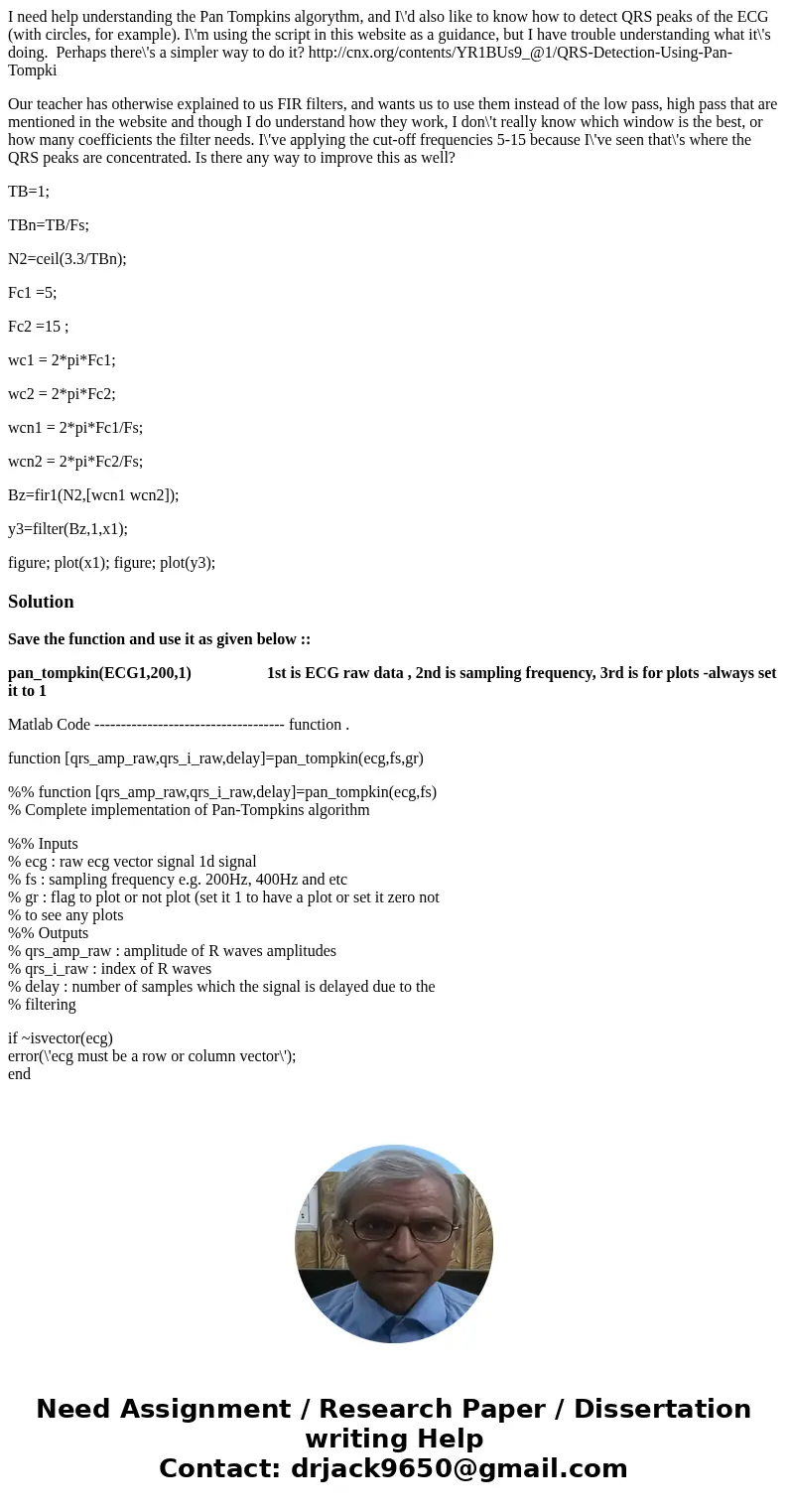
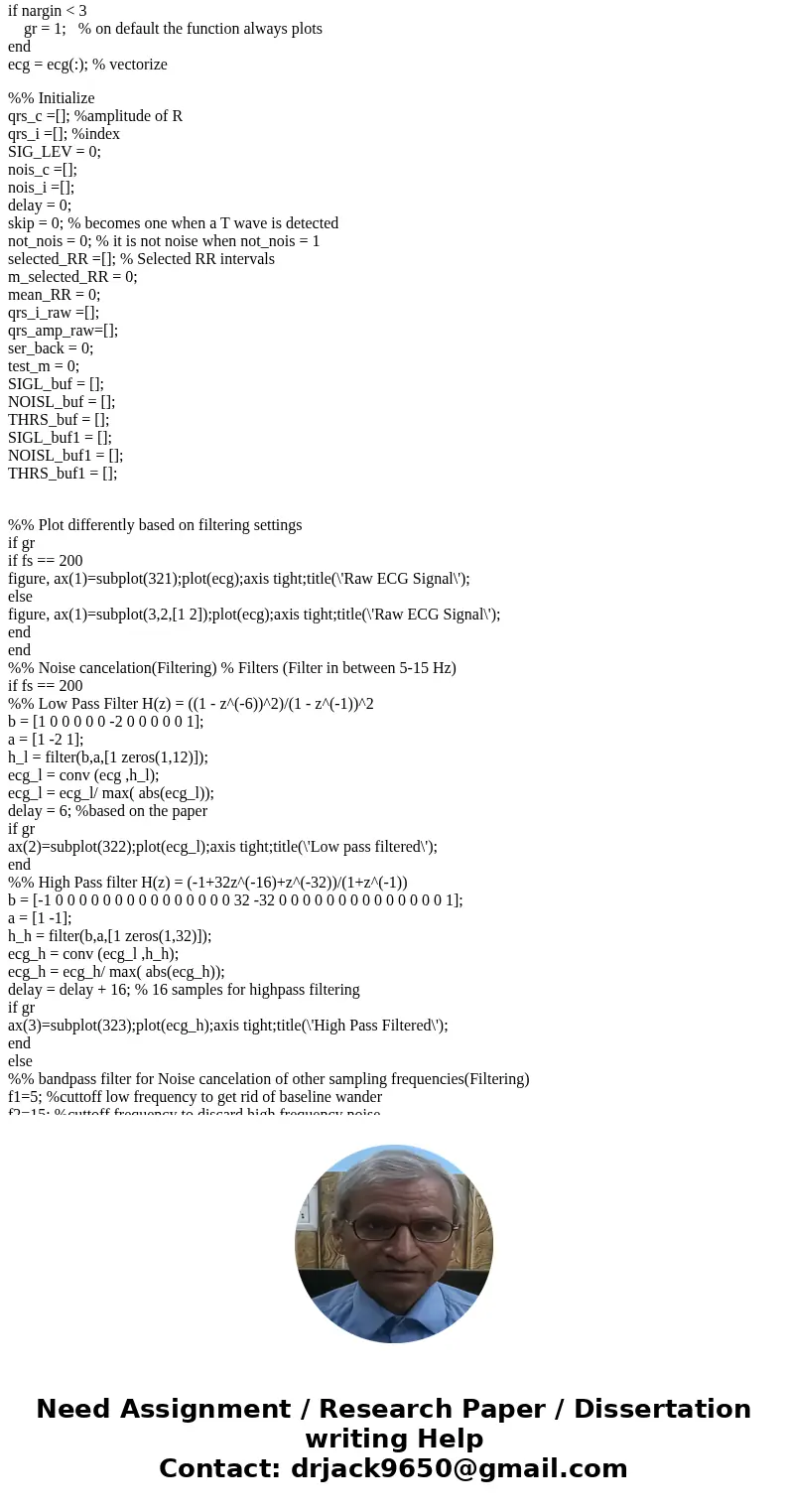
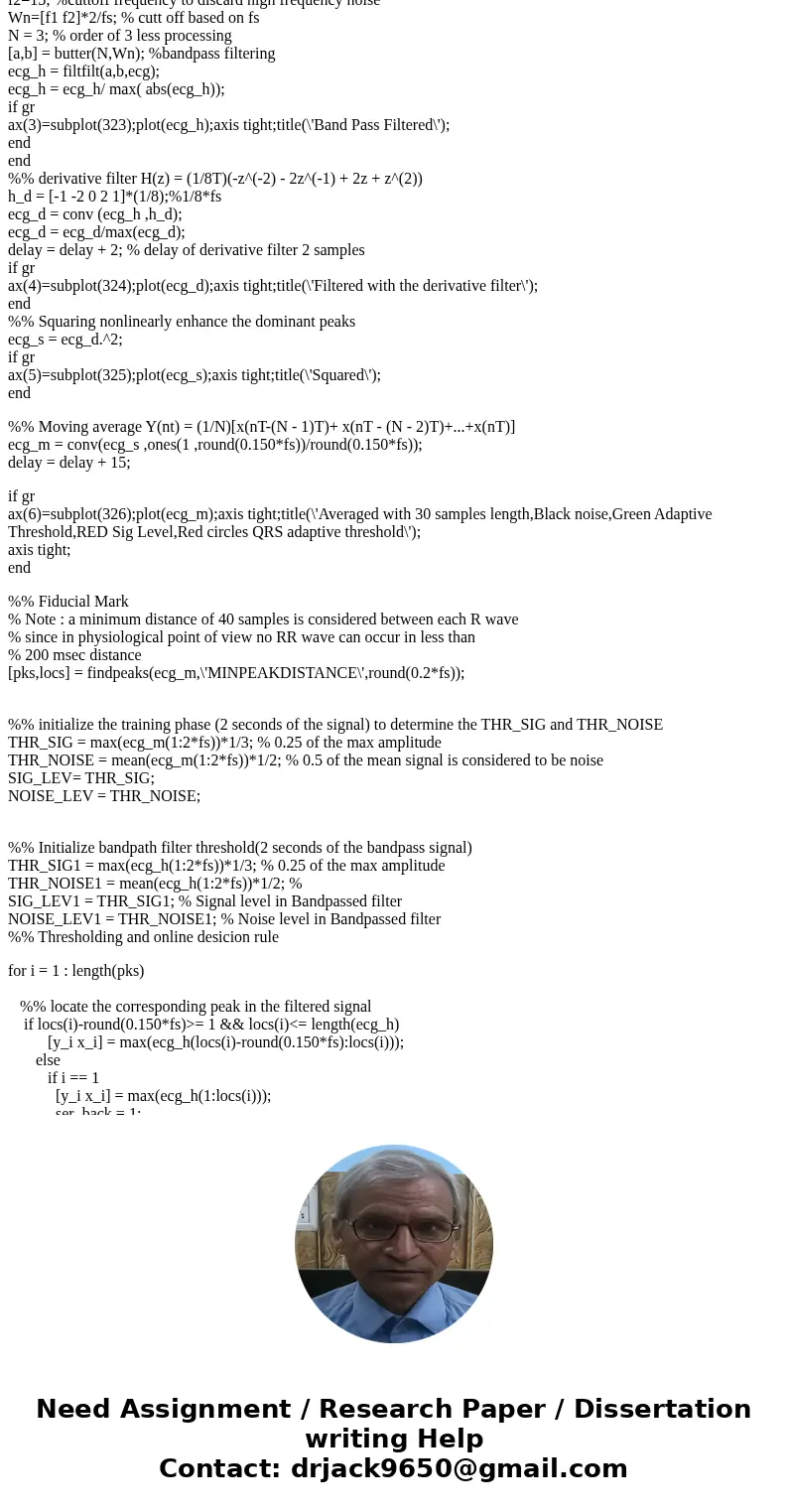
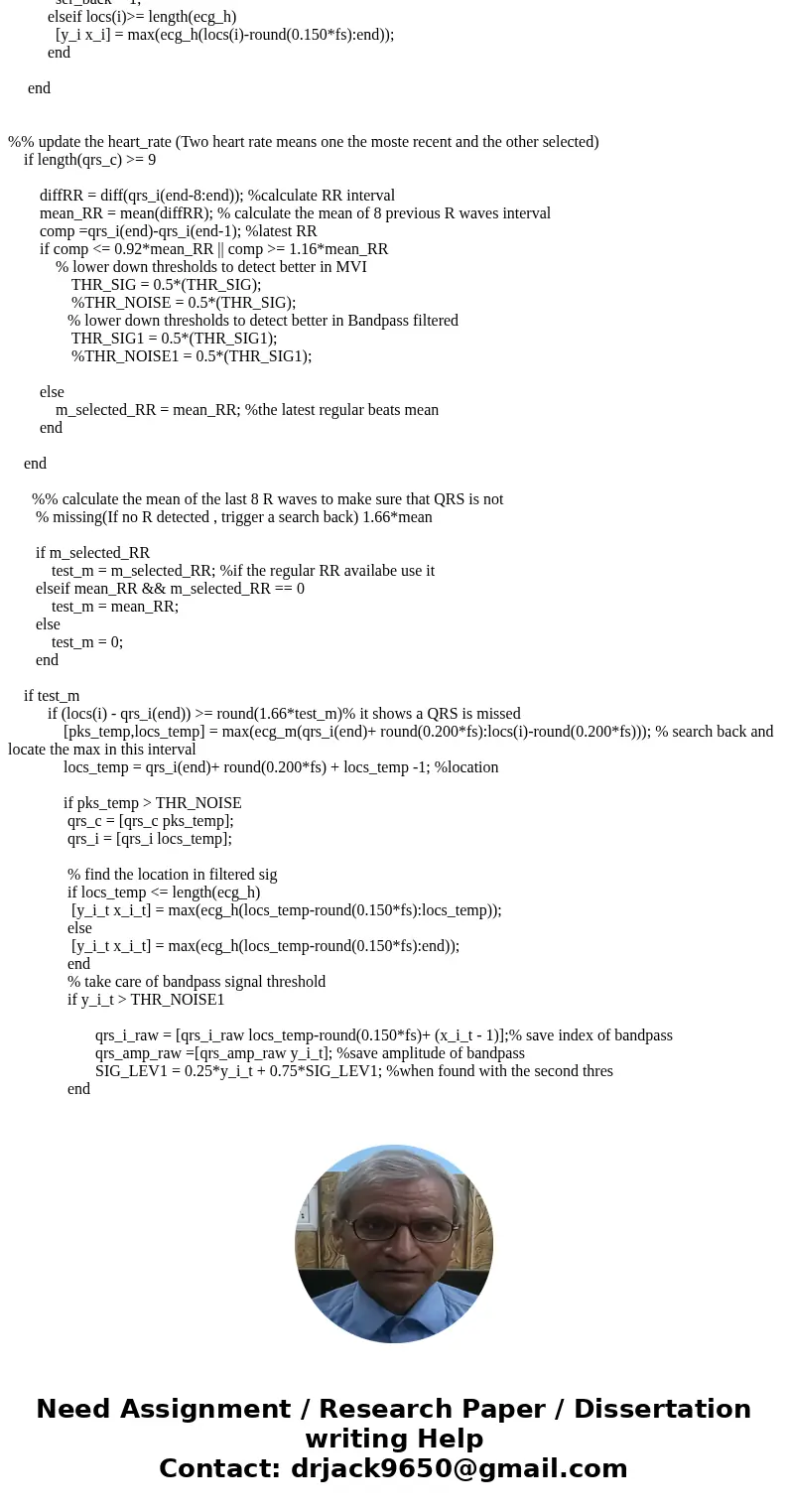
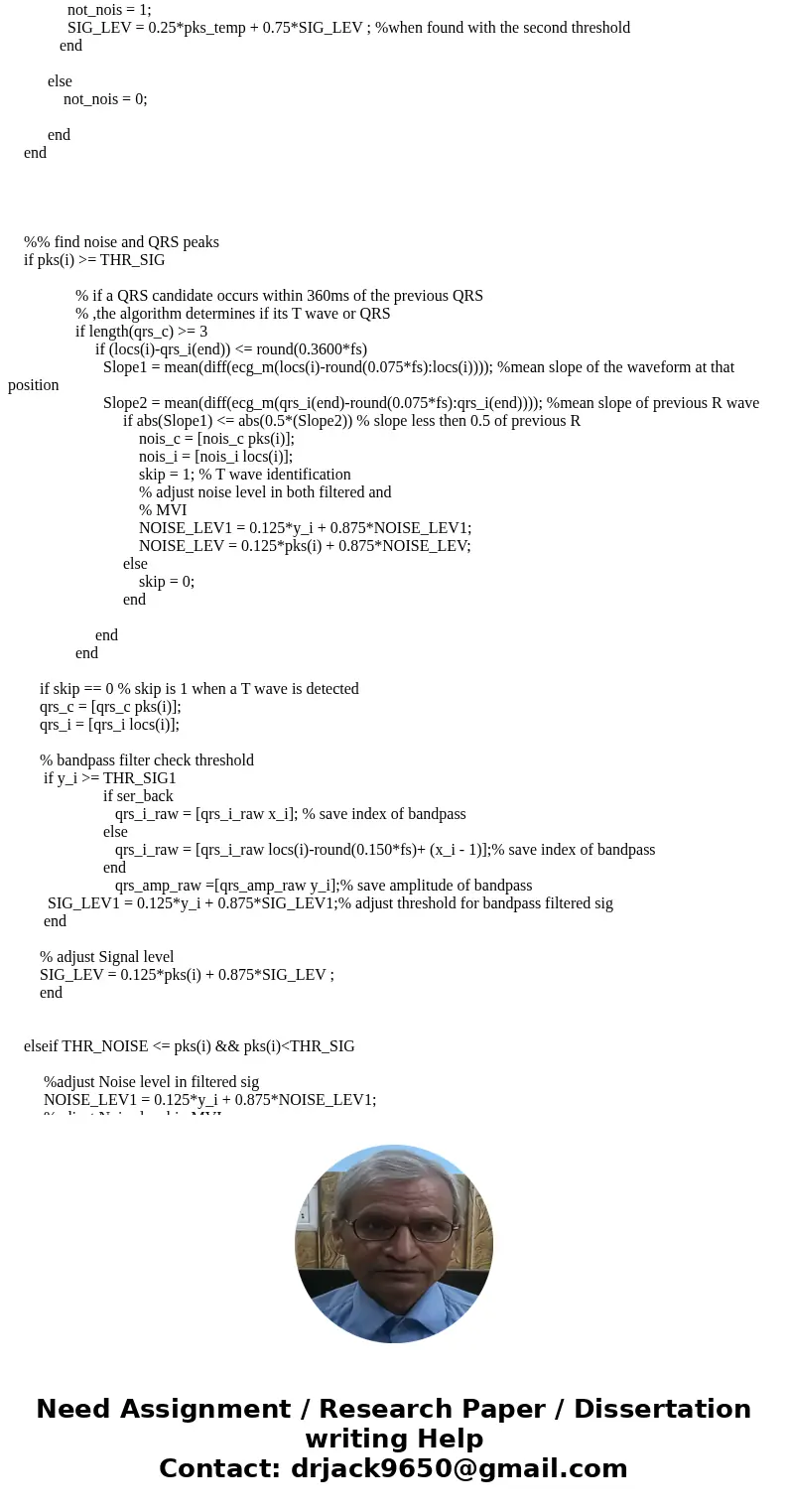
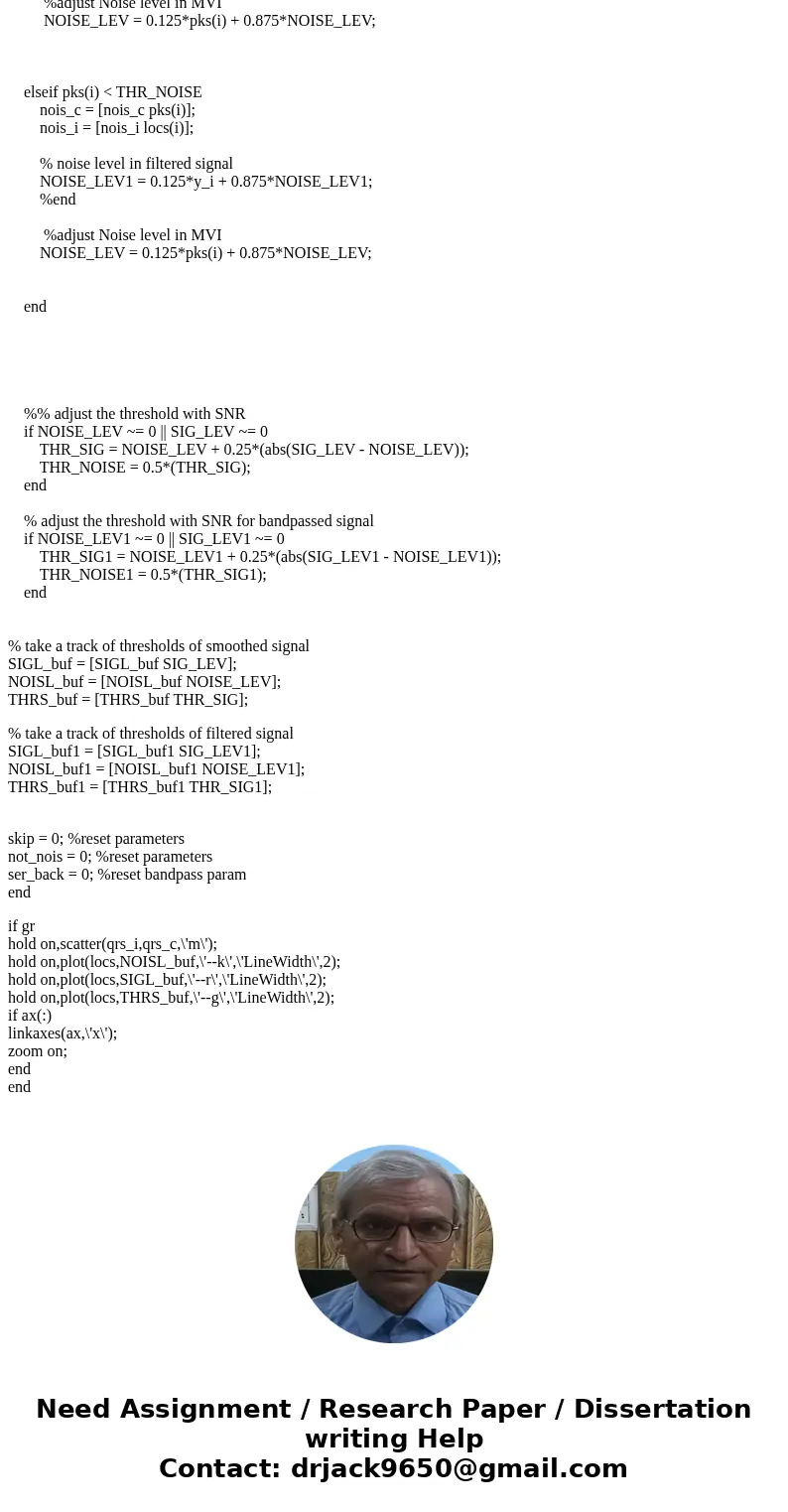
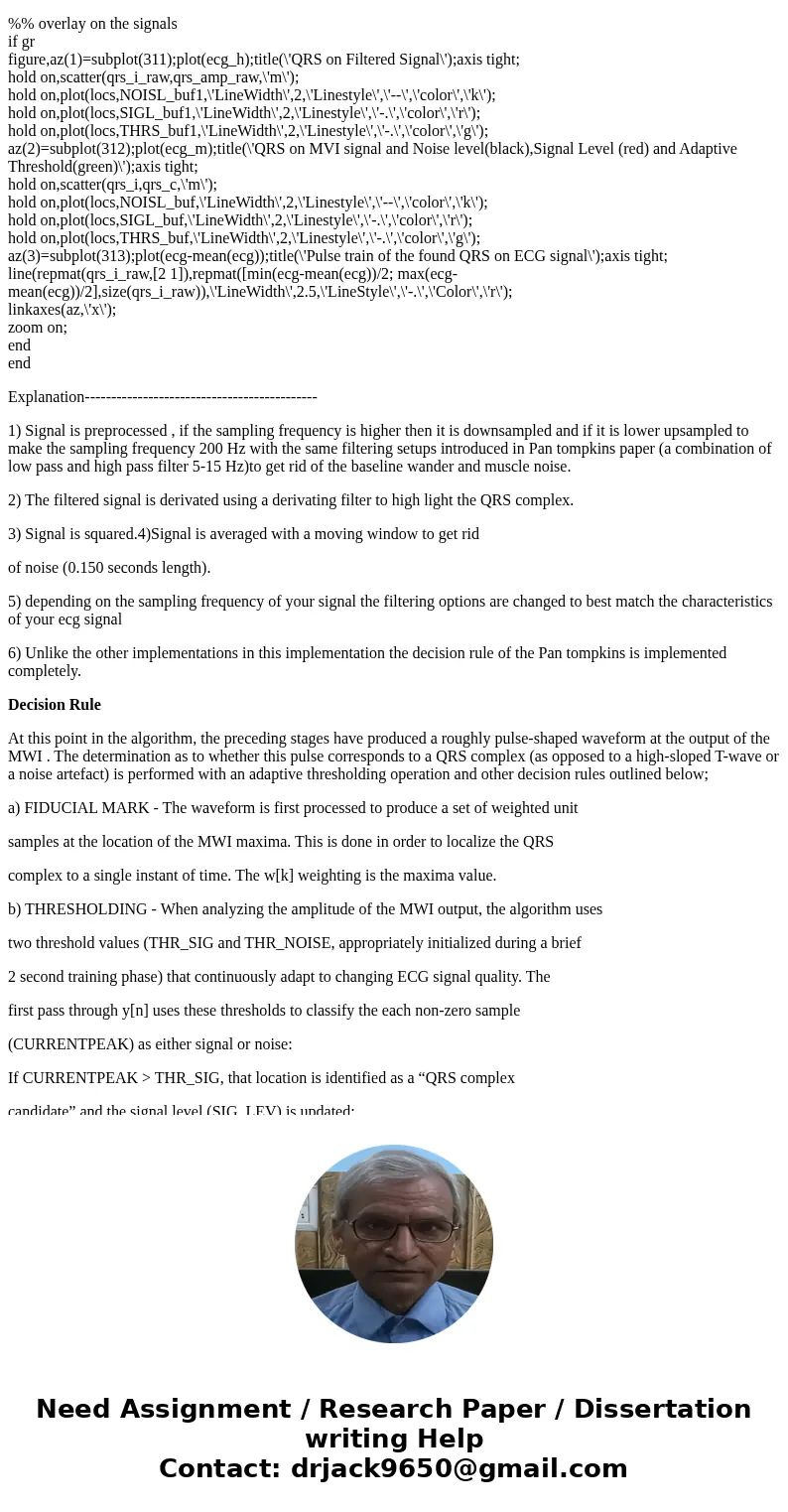
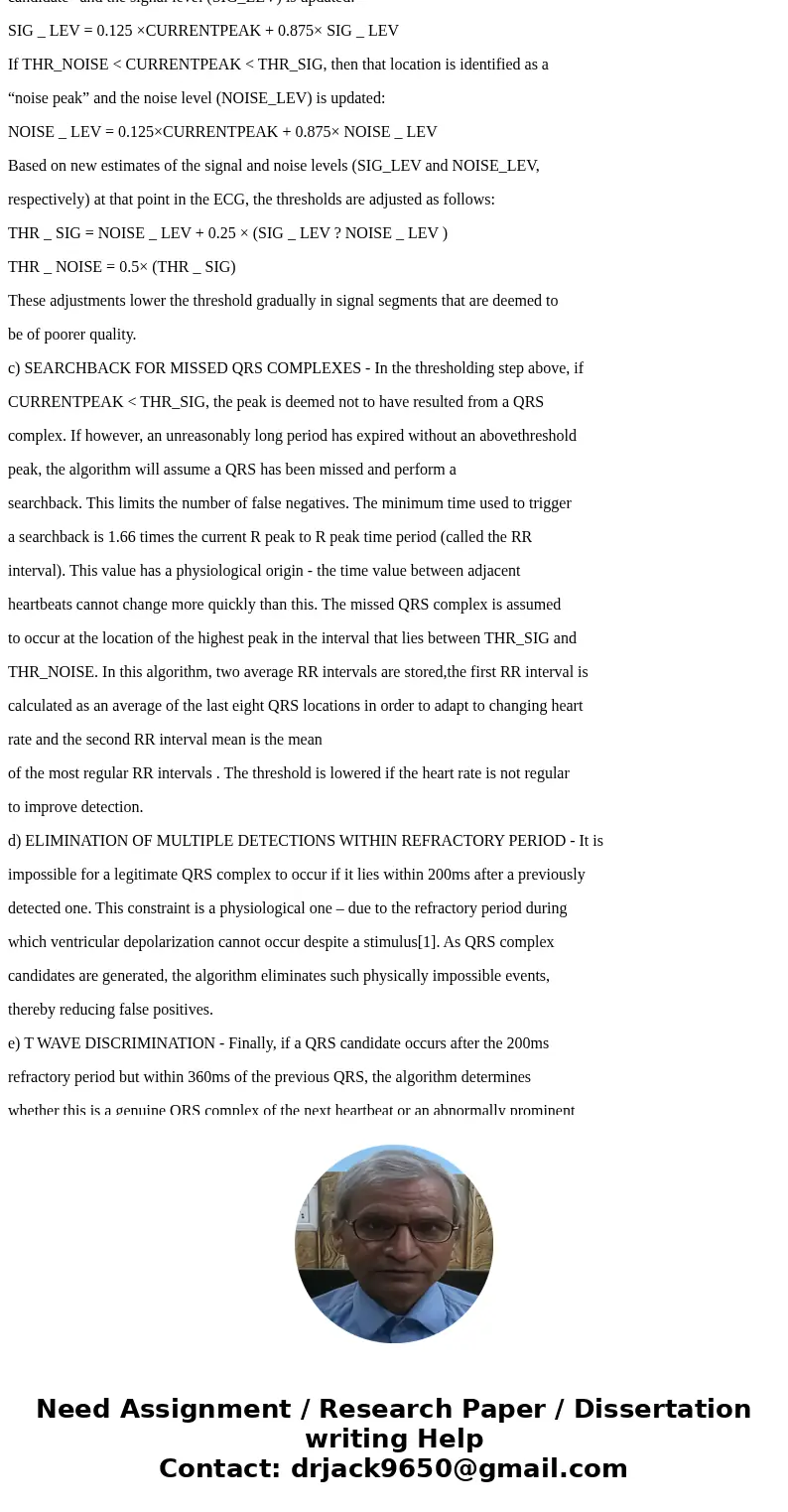
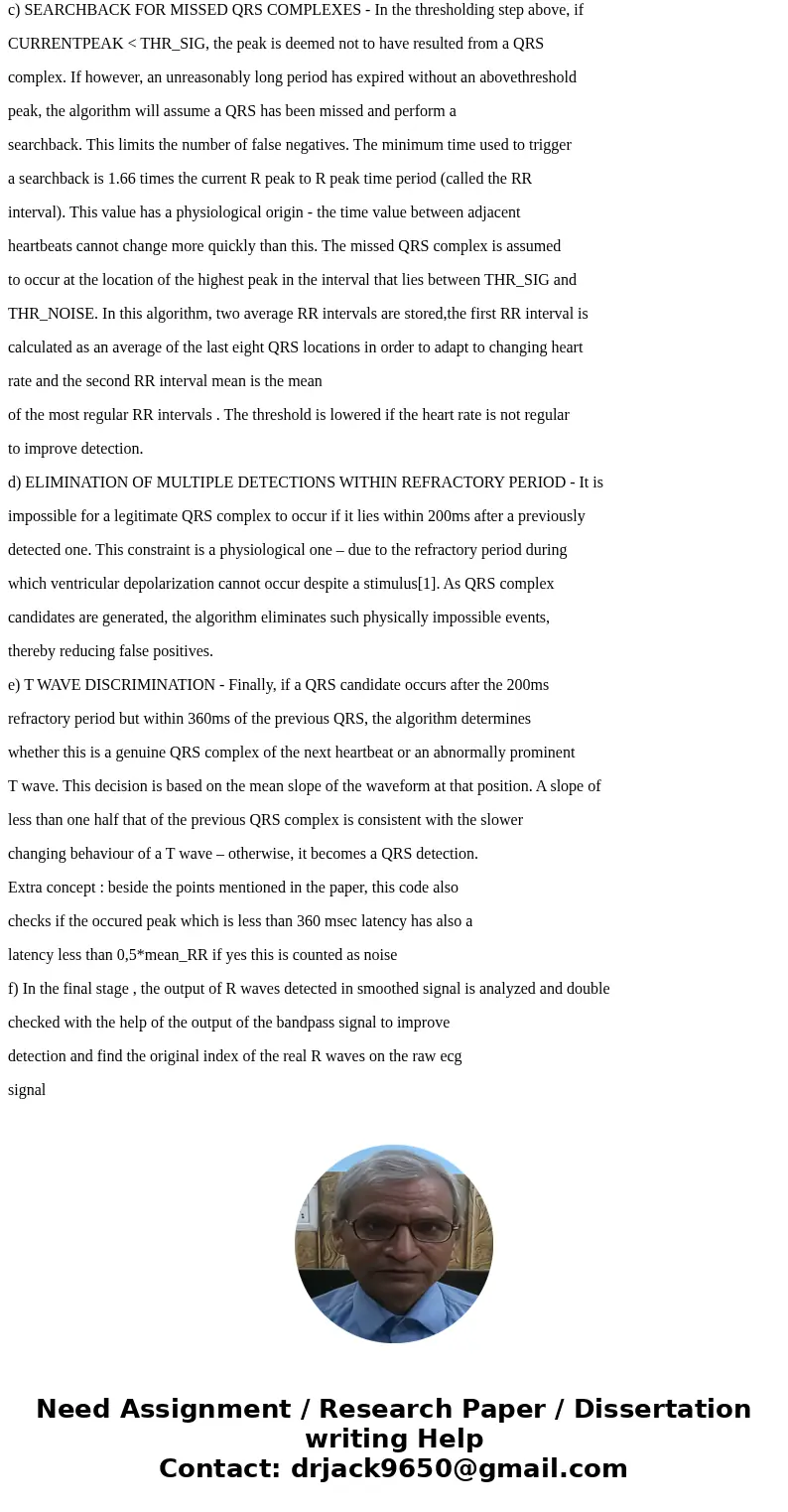
 Homework Sourse
Homework Sourse